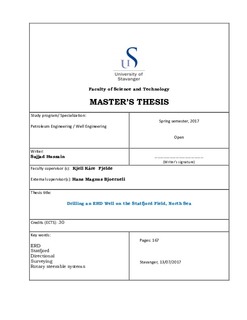| dc.contributor.advisor | Fjelde, Kjell Kåre | |
| dc.contributor.author | Hussain, Sajjad | |
| dc.date.accessioned | 2017-11-01T11:35:46Z | |
| dc.date.available | 2017-11-01T11:35:46Z | |
| dc.date.issued | 2017-04-05 | |
| dc.identifier.citation | Hussain, S. et al. 2017. Drilling an ERD Well on the Statfjord Field, North Sea. Paper SPE 185935 presented SPE Bergen One Day Seminar held in Bergen, Norway, 5 April. | nb_NO |
| dc.identifier.uri | http://hdl.handle.net/11250/2463414 | |
| dc.description | Master's thesis in Petroleum engineering | nb_NO |
| dc.description.abstract | Old platforms are not well known for extended-reach drilling (ERD) operations mainly due to rig and hydraulics limitations. ERD wells demand robust rig capabilities, good hydraulics systems, and equipment reliability. In addition, the well profile, rotary steerable system (RSS), measurement-while-drilling (MWD) and logging-while-drilling (LWD) tools, surveying, and new technologies are extremely important to the success in drilling an ERD well. RSS and drillpipe selection are important factors for hydraulics optimization. Surveying techniques are also important for time saving and improved efficiency. An ERD well in the North Sea Statfjord field was kicked off in the 17 ½” section from the openhole cement plug through a 50m window between the 20” casing shoe and 13 3/8” casing stump, ensuring a smooth well profile and reduced doglegs compared to the whipstock window exit. The 17 ½” section was drilled and landed at a 79° inclination using point-the-bit RSS technology, and the 12 ¼” section was drilled in two runs as planned using the point-the-bit RSS withstanding more than 550 hours down hole. The 9 5/8” liner was run and floated successfully in the ~6000-m section. Strict adherence to surveying techniques and quality control processes proved very helpful to meet Operator technical requirements. The 8 ½” section was drilled and landed on top of the reservoir with an inclination decrease from 88° to 35°. New MWD technology was successfully used in drilling the 6” section. These latest technologies as well as employing appropriate techniques help to drill ERD wells on aged platforms like those in the Statfjord field. Copyrights 2017, Society of Petroleum Engineers. Reproduced with permission of SPE. Further reproduction prohibited without permission [1]. | nb_NO |
| dc.language.iso | eng | nb_NO |
| dc.publisher | University of Stavanger | nb_NO |
| dc.relation.ispartofseries | Masteroppgave/UIS-TN-IPT/2017; | |
| dc.relation.ispartofseries | ;SPE-185935-MS | |
| dc.subject | ERD | nb_NO |
| dc.subject | Statfjord | nb_NO |
| dc.subject | petroleum engineering | nb_NO |
| dc.subject | petroleumsteknologi | nb_NO |
| dc.subject | directional drilling | nb_NO |
| dc.subject | surveying | nb_NO |
| dc.subject | rotary steerable systems | nb_NO |
| dc.subject | well engineering | nb_NO |
| dc.title | Drilling an ERD Well on the Statfjord Field, North Sea | nb_NO |
| dc.type | Master thesis | nb_NO |
| dc.subject.nsi | VDP::Teknologi: 500::Berg‑ og petroleumsfag: 510::Petroleumsteknologi: 512 | nb_NO |
